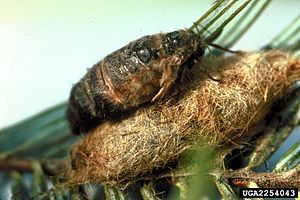Douglas-fir tussock moth facts for kids
Quick facts for kids Douglas-fir tussock moth |
|
|---|---|
 |
|
| Adult male | |
 |
|
| Adult female | |
| Scientific classification | |
| Synonyms | |
|
The Douglas-fir tussock moth (scientific name: Orgyia pseudotsugata) is a type of moth. It was first described by James Halliday McDunnough in 1921. You can find this moth in the western parts of North America.
Sometimes, the number of these moths grows very quickly in what are called "outbreaks." These outbreaks happen in cycles. The caterpillars of this moth like to eat the needles of trees like Douglas fir, true firs, and spruce trees during the summer. The adult moths fly around from July or August until November.
Contents
What They Look Like
Adult male Douglas-fir tussock moths are grayish-brown. They have light and dark spots on their wings. Their wings can spread about 25 to 34 millimeters (about 1 to 1.3 inches) wide. When they open their wings, you can see their brown back wings. Moths from the northern areas are usually darker, while those from the south are lighter. Their antennae look feathery.
Female moths are different; they cannot fly. They only have very small, undeveloped wings.
The young moths, called larvae or caterpillars, are quite colorful. They are about 20 to 26 millimeters (about 0.8 to 1 inch) long. They have red spots and white spines. They also have bright white tufts of hair with red tips, which are called "tussocks." Long, black hairs stick out from their front and back ends.
Where They Live and What They Eat
The Douglas-fir tussock moth lives naturally in the forests of western North America. Outbreaks have been seen in places like British Columbia, Idaho, Washington, Oregon, Nevada, California, Arizona, and New Mexico.
These outbreaks usually happen in cycles, about every eight to twelve years. They typically last for up to four years, but sometimes longer. For example, a big outbreak was reported in Idaho and Washington in 2011.
The caterpillars mainly eat the needles of Pseudotsuga (like Douglas fir) and Abies species. Their favorite trees include Douglas fir, grand fir, white fir, and subalpine fir.
Life Cycle
The life of a Douglas-fir tussock moth begins when eggs hatch in the spring, usually from May to June. The tiny caterpillars start eating the new needles that have just grown on the trees. As they grow, they also eat older needles.
Caterpillars move around a lot, which helps them spread to new places. They can spin long, silky threads. If they drop from a branch, these threads can catch the wind, helping them travel to other branches or even other trees.
In July or August, the caterpillars spin a loose, web-like cocoon. Inside this cocoon, they change into a pupa. This is a resting stage where they transform into adult moths.
Adult moths come out of their cocoons and are active until as late as November. The female moths, since they can't fly, stay close to the cocoons where they hatched. They mate right away.
The female moths then lay their eggs. The eggs are round and white, and they are laid in a big mass. This egg mass helps protect them through the winter. Because the female moths don't move far, new outbreaks always start in the same area where the previous generation lived.
How Outbreaks Are Managed
One important way to deal with tussock moth outbreaks is to find them early. Scientists who study insects, called entomologists, watch the forests carefully. They use special traps that contain scents (called pheromone traps) to detect if the moth population is growing.
Most outbreaks will eventually stop on their own. However, forest managers can use certain methods to help the trees. Sometimes, a special spray called carbaryl can be applied from the air to help control the moths.
Gallery









